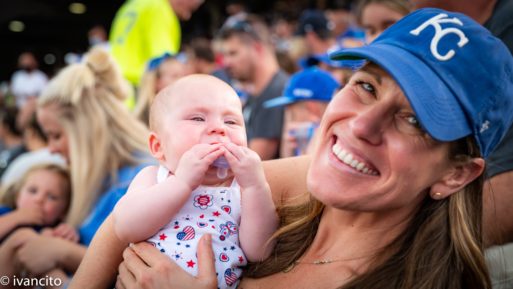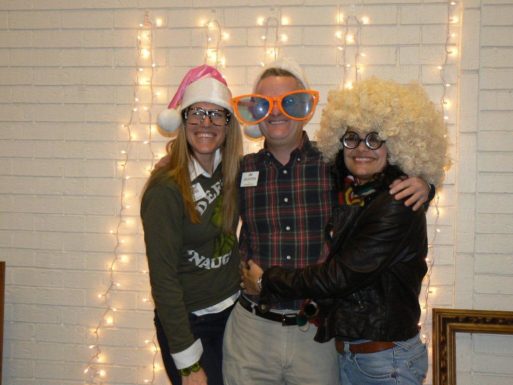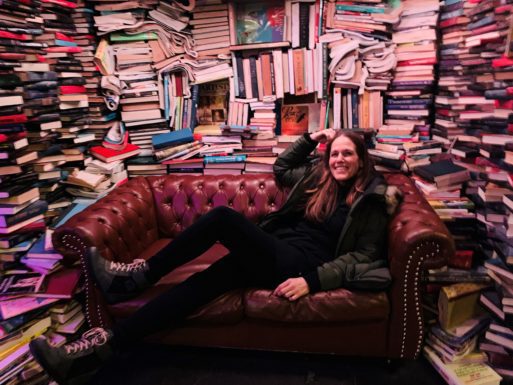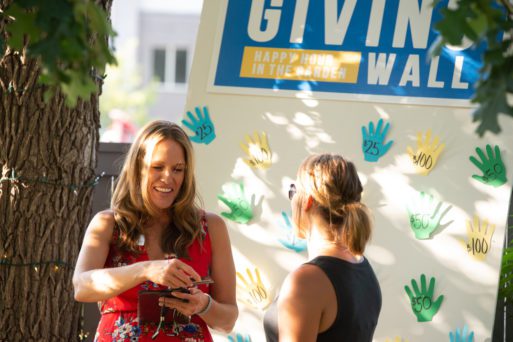
Burns at a baseball game with family
Credit: Courtesy of Michaeleen Burns
Child and family psychologist Michaeleen (Micki) Burns can relate to bereaved children. She was first drawn to the field because she was inspired by her parents to give back. Her father was a school teacher and her mother raised eight children. Then, when Burns, who lived in a small town in Kansas, was a senior in high school, a good friend of hers was murdered. “It really shook our town,” Burns said. “I’d already decided at that point that I wanted to go into social work and psychology and wanted to work with children, but this solidified that path for me.”
Burns’ motivation to support bereaved children was further inspired by her father’s massive stroke during the summer before her sophomore year in college, which left him incapacitated and hospitalized for over a year. Her mother developed cancer during his recovery. She was diagnosed around the time he came home from rehabilitation and died eight months later. “There was a lot of grief for me in those formative young adult years, and a lot of gratitude for the family that I came from – having seven siblings who came together,” Burns said. After obtaining her doctorate in psychology, she worked at a child and family nonprofit in Dallas, Texas, for 10 years before moving to Denver, Colorado, where she now enjoys the mountains while serving bereaved children and families as the chief clinical officer at Judi’s House/JAG Institute.
Who does Judi’s House serve?
We serve children and families who have experienced any significant death loss. They get to tell us what a significant relationship is; we don’t have any restrictions on whether it’s a sibling, a parent or a grandparent. It could be a teacher, a neighbor, or just a caring adult or significant friend. As long as there’s a child between the ages of 3 and 25, we serve the entire family, regardless of how long ago the death was.
Are they all in the Denver area?
Mostly, though we do have some folks who will drive up from Colorado Springs or from the mountains. We also offer some training and education to bereaved children and parents, and to professionals and educators, that reach much more broadly.
What does your bereavement care look like? What kind of programs do you offer?
Our direct services really involve three primary programs. We have a group-based curriculum that we’ve developed called Pathfinders; it’s 10 sessions. We offer that both in our community and in schools for students who are bereaved. We also offer it here at Judi’s House, in a family format. Each family member goes into a group that’s developmentally appropriate for them and suited to where they are cognitively and emotionally. They’re covering the same topic, but with peers. Once families have completed Pathfinders, they can go into a program called Connections, which meets a little less frequently but offers ongoing support. And then for kiddos or families who have needs that can’t be met in that group format, we offer individual, family, couples and play therapy.
How do your programs differ from other models of grief counseling?
We’re unique in that we have licensed clinicians, or individuals who are becoming licensed clinicians, in all of our programming – professional counselors, clinical social workers, marriage and family therapists and psychologists. So while we see our program as a preventive intervention, we have that ability to serve a wide array of bereaved children. You would never get turned away from Judi’s House because you’re not grieving enough. At the same time, for those experiencing some pretty significant grief disruption, we have the staffing and the level of skill and competence to be able to care for them. That said, there are situations where children and caregivers come in and there are other issues involved, such as substance misuse or domestic violence, so we connect them with other providers in the community.
Why do you believe that the approach that you’re taking is effective?
One of the reasons is that it’s informed by the participants: we are constantly seeking feedback from the families and making adjustments. There is also an incredible sense of connection and community. For a 12-year-old child who’s experienced the suicide loss of a sibling, sitting in a room with other kids who share the same experience can take away some of the taboo and the shame. We have a lot of our caregivers who say, “I came for my child, but I didn’t realize how much I needed this support.” We know that the number one predictor of how well a child will adjust to loss is how well their primary caregiver supports them and how well they themselves adjust, so that is why our model really takes that family-based approach. Finally, we have a doctoral-level psychologist who heads up our evaluation and research division, as well as a number of research managers and assistants who are constantly collecting both qualitative and quantitative data on our programming to help us look at what’s working.

Burns, left, in celebration mode
Credit: Courtesy of Michaeleen Burns
I was going to ask about the JAG Research Institute. Is that mostly focused on improving your specific programming or is it also focused on general research into bereavement for families and children?
We have really balanced looking closely at the programs we offer at Judi’s House with information and tools that we can provide to the field and to the country at large. In addition to quarterly evaluations of our services, we have two really exciting tools on the evaluation research side, one being our Childhood Bereavement Estimation Model. It’s a quantitative statistical tool that takes inputs from national data sets to estimate the number of bereaved children who will experience the death loss of a parent or a sibling, and it looks at the prevalence in different areas and among different populations. That really plays into this other program that we started two-and-a-half years ago, called the Childhood Bereavement Changemaker program, which is an opportunity for other centers, programs and individuals across the country to work with us. Both of these are funded in partnership with the New York Life Foundation, which is the largest funder of childhood bereavement in the country.
So what is the prevalence of bereavement nationwide for children?
I’m going to share our 2022 numbers, which we’ll be releasing this month. We look at the most recent five years of data available, so the data is from 2016 to 2020 and includes the first year of the pandemic. We were really interested to see what we would find. We saw a significant increase in childhood bereavement – from one in 14 children in the 2021 report to one in 13 children in 2022. When we looked at the types of death losses in 2020, we found clearly that COVID-19 played a role, but we also found that deaths due to accidents – which are largely overdose death losses – and homicide death losses played a significant role. So while there’s a lot of attention right now on children bereaved because of COVID-19, we don’t want to lose sight of the 5.2 million children who even prior to the pandemic were expected to experience the death of a parent or sibling by their 18th birthday. Our current estimate is 5.6 million children. That’s 7.7% of children in the U.S.

Burns poses among an array of books at Meow Wolf in Denver, Colorado
Credit: Courtesy of Michaeleen Burns
What kind of resources do these children and families need?
It really begins with basic awareness and educating the public about how to be a support to bereaved children. That is the other element that we offer: training education so that when a child has experienced a death loss and they turn to their teacher, their basketball coach or somebody in the community, that individual is responding in a way that we know is supportive. Really educating children too, about why it’s important to be there for your friends who have experienced a death loss as opposed to shying away from it, which is our tendency as a society. From there, we believe that the next level of support is training and education for professionals, including psychologists like myself, but also nurses, doctors, teachers–all the individuals who interact with children in a number of different settings. That way it’s something that we’re cognizant of, so when a child comes to the school nurse’s office with consistent headaches, we’re asking about any changes in the family that may be impacting them. The next level would be peer support programs – there are a number of excellent ones across the country, where it’s really a space for kids to connect with kids around the types of experiences that they’re having. And then moving into those group, therapeutic supports all the way up to the more intensive individual, family, play therapy types of interventions.
What would you recommend to a caregiver or a teacher who encounters a child who’s grieving?
The most important thing for us as adults to keep in mind is we can’t fix grief. It’s not something that we’re going to solve or resolve; we need to be with somebody as they journey through. The developmental age of a bereaved child makes a big difference – our four-and five-year-olds tell us that they’ll walk up to a stranger in a grocery store and say, “My daddy died.” And the stranger is like, “Where’s your mom?” Because we don’t know how to respond to that. We don’t know how to say, “Oh dear, that had to be so hard. Tell me about it.” Meanwhile, with our teens, the caregivers are saying to us, “They haven’t said a word. Please tell us what they’re saying.” So it’s really approaching it as, “I’m going to be here for you, I’m going to commit to this relationship. I’m not going to force you to talk about this, but I’m going to let you know that there’s an open door, and I’m going use all the tools in my toolbox to hopefully get us to a place that we can have those conversations.”
How many children and families has Judi’s House served over the years?
We’ve served 12,000 children and caregivers since we started 20 years ago. This year is our 20-year anniversary, and we’re really excited about hitting this milestone. Prior to the pandemic, we were serving about 1,600 individuals each year, and that’s obviously decreased as we’ve moved towards social distancing and creating a safe environment to allow for in-person processing. We hope to start getting back to those pre-pandemic levels of service soon.

Courtesy of Michaeleen Burns
What would you like to see nationally, policy-wise, that might better support these children and families?
I really wish that there was funding for grief support. Right now organizations like Judi’s House or The Dougy Center or the Children’s Bereavement Center of South Texas – we’re out pounding the pavement, trying to get grants funding from dedicated community members who have a big heart for bereaved children, but it limits what we’re able to truly do. If there was a way for organizations to get reimbursed without having to give a diagnosis, that could be a game-changer for raising the level of knowledge and information that we have about what works for children and about how to customize the programming and services that children need to their specific levels. The New York Life Foundation has made such a difference with their funding, but they can’t do it alone.
You mentioned diagnosis. Is there pressure to diagnose people in this field? I know there’s a new diagnosis of prolonged grief disorder in the DSM – how do you feel about that?
We don’t diagnose at Judi’s House. We’re very fortunate in that we’re able to rely on funding from foundations and donors, and so we don’t have that pressure because we’re not getting reimbursed for our services. And at the same time, our board is constantly asking us, “Are you leaving money on the table? Is there a way that we could be bringing in revenue here?” We don’t want to pathologize grief. We do not want to be part of a movement that says, “Okay, well, let’s just give every kid that walks through the door a prolonged grief disorder diagnosis if they can qualify, or an adjustment disorder diagnosis if they can’t, and start billing insurance.” We also believe that there are situations where individuals’ grief reactions have reached a level of severity where having a diagnosis may help them to get the level of care that they need.
Is there anything that I haven’t asked that you would like to add?
Sometimes I feel when I’m talking about our services that the stories of the children don’t get centered, and they are the reason why we’re here – they’re the individuals who teach us every day about why it’s so important to show up for them.
Are there any stories you want to share?
Oh gosh, I have so many. There’s a young woman who was a teenager when she came to our program. She was a great athlete and an amazing student. But her brother died by suicide, and after his death, none of that had meaning for her anymore. In the process of working with Judi’s House and connecting with a therapist outside, she really started to consider suicide herself, and ended up in a partial day hospitalization program. She came through that with a level of post-traumatic growth to where she is now someone who is a fierce advocate for individuals who are experiencing suicidal thoughts, suicide attempt survivors and suicide prevention in general. To me, her story highlights the importance of allowing people to work through their grief.
Thank you, Micki, for sharing your insights about child and family bereavement.

 Young and Grieving: The Key to Supporting Bereaved Children
Young and Grieving: The Key to Supporting Bereaved Children


 How Dare You Die Now!
How Dare You Die Now!
 Debating Medical Aid in Dying
Debating Medical Aid in Dying
 “Help Me, Helen”
“Help Me, Helen”














